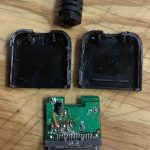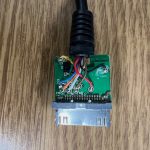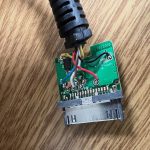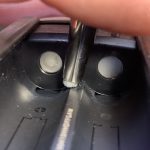When I bike (or do just about anything else) outside during winter time my fingertips annoyingly and temporarily lose circulation. Chemical packs help when the temperature goes below zero degrees F, but I don’t always remember to keep them with me and they don’t do much for my thumb. My last bike commuter buddy, Rutager, told me he enjoyed using Snow Deer heated gloves for Nordic skiing last winter. My second-to-last commuter buddy, my Dad, saw Fieldsheer’s Mobile Warming Squall Heated Gloves (MWUG29010622) at Costco and picked up a couple pairs, XL and XXL, for me to try out. I decided to pit the two manufacturer’s gloves against each other in a face-off for future time with my hands, here’s what I found out.
Before we get started, I gave the Fieldsheer an initial fit-test by trying them on for size. The back of the packaging recommended XL gloves should fit me; however, XL gloves were too tight so I returned them and kept the XXL for the test. Fieldsheer XXL versus Snow Deer XXL is the challenge!
The gloves are somewhat similar in appearance, both black with a heater control button on the backside offering 4 levels of heat: high, medium, low, and off. The Fieldsheer gloves are a bit longer, offering more wrist coverage. With batteries, a pair of XXL Snow Deer weigh in at 427 grams and the Fieldsheer XXL come in at 461 grams. Not a big difference.
I tested each pair for heat output and didn’t notice much of a difference based on touch, they seem to heat up at a similar rate and provide a similar maximum temperature. I didn’t measure the heating rate or absolute temperature with instruments, but the difference appears insignificant. Unlike the Snow Deer gloves the Fieldsheer offer 60-gram 3M Thinsulate – I didn’t test outdoors, but it’s possible the Fieldsheer’s insulation will retain temperature better outside.
Appearance is nearly identical; however, the Snow Deer show off a bright red LED that is really bright. The Fieldsheer isn’t as bright offering lower profile light for daily use, but does have a physically higher-profile button that may get in the way more often than the Snow Deer’s button. Since I haven’t used either glove outside yet, I can’t say whether any of these features is a hindrance or help.
The Snow Deer XXL fit on my hands may be close to perfect, whereas the Fieldsheer XXL were not as snug and seemed to not want to bend with my fingers as easy as the Snow Deer. The winner for soft touch inside the glove is the Snow Deer and Tina agreed. I give the edge to Snow Deer on fit.
Glove function (i.e., taking the gloves on and off and using the heater control button) is something I expect to be important going forward. First, the index fingers on both gloves interact with the replaced screen on my iPhone XS Max – I don’t need to type full emails with the gloves on, but being able to swipe and read a text message makes these gloves useful. For removing my hands from the gloves (something I do more often than I should in the winter time while riding) the Snow Deer seemed to behave more as a cohesive single glove, whereas the Fieldsheer’s liner seemed to want to separate from the outer shell. Liner-from-shell separation may be a design advantage for folks who want to turn theirs inside out for post-ride drying; however, with a heat supply inside the glove I don’t expect these to get wet and I prefer the ease of taking the gloves on and off at-will. While the Fieldsheer gloves have status indicators directly on the batteries, the reality is that the on-battery indicator is not visible while it is tucked into the glove’s zippered pocket. I give a slight edge to the Snow Deer gloves on function.
On cost, I used eBay to score the Snow Deer gloves at half the price of the Fieldsheer gloves from Costco. It’s not fair to give an advantage to Snow Deer here, as I didn’t even look to see if there were deals on Fieldsheer heated gloves. If buying new from a reputable distributor, the cost of the gloves is comparable.
Warranty: each manufacturer offers a 1-year warranty, push!
Wall charger: the Snow Deer gloves come with USB cables and a power adapter to charge the 7.4-volt batteries; the USB cable has an inline buck converter that takes charging voltage from the 5-volt power adapter up to 8.6 volts. The Fieldsheer came with USB cables that can be plugged into a 5-volt power adapter, but no adapter. Slight edge to Snow Deer for providing a power adapter.
Batteries: the Snow Deer offer a 2200 mAh battery to each glove that put out 7.4 volts and charge at 8.6 volts, whereas the Fieldsheer have 4700 mAh batteries that put out 3.7 volts and charge at 5 volts – these batteries have roughly the same total output. I’m giving an advantage to the Fieldsheer batteries, because I rock Exposure lights on my bike that charge at the same voltage, which means I could possibly use the same charger for my lights and gloves.
Minor annoyance: the Fieldsheer glove packaging has QR codes that, when scanned, bring me to a server that is unavailable.
In the end, I chose the Snow Deer XXL gloves and will return the Fieldsheer XXL gloves to Costco. I am not completely ruling out the Fieldsheer gloves though and the points above may bring me back. Also, Fieldsheer offers a plethora of other products on their website, including heated soles, so I may be back to take care of toes like my now lucky fingers.




